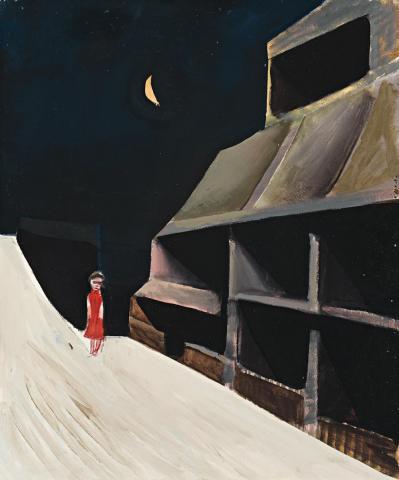GIRL IN A LANE, 1952
CHARLES BLACKMAN
oil on pulpboard
76.0 x 63.5 cm
signed indistinctly lower right: BLACKMAN
Tolarno Galleries, Melbourne (label attached verso)
Private collection, Sydney, acquired from the above in 1989
Private collection, Sydney
Charles Blackman: The Schoolgirl Years (1951–1953), Tolarno Galleries, Melbourne, June 1988 (38 paintings)
This rare and striking painting from the formative years of Charles Blackman's art provides a matchless introduction to his schoolgirl series of paintings and drawings of the early 1950s. Disquieting in its isolation of the red-dressed figure within the long and lonely street, of darkness surrounded in houses from which no lights shine, the painting draws upon his experience of the suburban lanes and ways of East Melbourne and Hawthorn. While the deserted street adds a surreal touch reminiscent of Giorgio de Chirico, Blackman uses it brilliantly in Girl in a Lane and throughout the schoolgirl series as a deeply moving metaphor of solitude and loneliness. The orange moon hangs alone in the sky, shedding its brightness in a path of moonlight, adding to the haunted look and the girl's vulnerability. She casts no shadow. Those shadows within the terrace houses are cut by sawtooth angles of light, precursors of the aggressive roof angles in the schoolgirl paintings. Of one such painting, Prone Figure, 1953, Museum of Modern Art, Heide, Felicity Moore writes of 'the uniform pink roofs of buildings [which] bite into dark shadows.'1 Moreover, the terraces in Girl in a Lane rub shoulders in exclusive attachment, what shelter they may offer the child, denied. Anxieties of his own childhood populate this and other similar paintings, of Blackman the young schoolboy whose sisters had the front door key. They are remembrances of alienation, of being locked out, waiting, and other like childhood dramas in urban settings.
Another early Blackman painting, Running Boy, Walking Girl in the collection of the Newcastle Region Art Gallery, shows the same starkness of primary colours. Here, the red dress and blue shirt against a black background evoke emptiness. Although a girl and boy are present, isolation is still the theme. Dominated by the setting, they draw away from each other - one walking, the other running. In Girl in a Lane Blackman's gifted presentation of children's understanding - seeing things the way they do - called upon his own experiences in recollections of youth where time stands still. Nothing moves. All is as in a dream, imbued with the disarming simplicity and poetic enchantment that are the hallmarks of Blackman's art.
1. Moore, F., St. J., Charles Blackman: Schoolgirls and Angels, National Gallery of Victoria, Melbourne, 1993, p. 44
DAVID THOMAS
